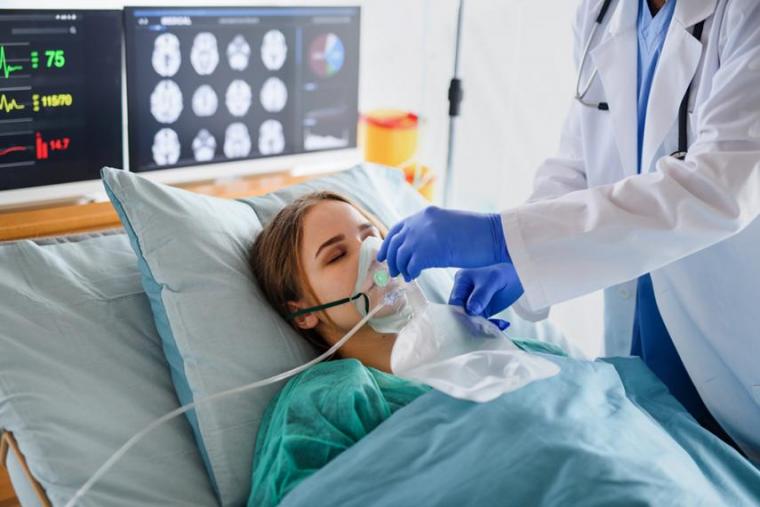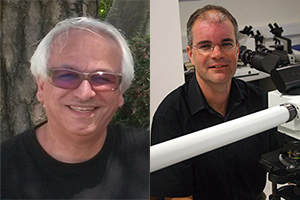
The University of Guelph’s Office of Research and the College of Engineering and Physical Sciences (CEPS) have awarded $126,000 to CEPS researchers [1] for nine projects designed to support the battle against the COVID-19 pandemic and mitigate its impacts. Five of the projects focus on testing, screening and treatment of the virus SARS-CoV-2.
 A group in the School of Computer Science led by Prof. Andrew Hamilton-Wright, in partnership with IRIS R&D Group of Burlington, is exploring ways to conduct larger-scale and less invasive symptom testing for those in vulnerable settings such as hospitals and long-term care homes. This distanced-based method will calculate metabolic markers such as breath rate, heart rate and skin temperature to help front-line personnel evaluate symptoms, triage, and monitor until test results can be determined.
A group in the School of Computer Science led by Prof. Andrew Hamilton-Wright, in partnership with IRIS R&D Group of Burlington, is exploring ways to conduct larger-scale and less invasive symptom testing for those in vulnerable settings such as hospitals and long-term care homes. This distanced-based method will calculate metabolic markers such as breath rate, heart rate and skin temperature to help front-line personnel evaluate symptoms, triage, and monitor until test results can be determined.
“Our novel technology operates at a two-metre or greater distance from a patient, requiring no direct contact,” says Hamilton-Wright. “This will protect healthcare workers by providing a faster and safer way to diagnose. Once we have tested the prototype through our collaboration with St. Joseph’s Healthcare Hamilton, the final product can be quickly deployed to healthcare systems across Canada.”
 While this initiative is tackling more effective testing methods, Prof. Richard Manderville, Department of Chemistry, is seeking ways to hasten tests results captured through an innovative new testing method. When a test is performed, a nasal swab is taken and polymerase chain reaction (PCR) is used to detect characteristics of the virus to confirm its presence. This PCR testing can take up to five days for results, and while some companies are seeking to expedite these results, Prof. Manderville is developing an entirely new diagnostic tool. Manderville’s team will incorporate a fluorescent dye into nucleic acid biosensors called “DNA aptamers” that can specifically bind to SARS-CoV-2. The binding of DNA aptamers to the virus could then be used as the basis for a rapid detection platform that could be used to diagnose people with the virus much faster than current PCR-based methods
While this initiative is tackling more effective testing methods, Prof. Richard Manderville, Department of Chemistry, is seeking ways to hasten tests results captured through an innovative new testing method. When a test is performed, a nasal swab is taken and polymerase chain reaction (PCR) is used to detect characteristics of the virus to confirm its presence. This PCR testing can take up to five days for results, and while some companies are seeking to expedite these results, Prof. Manderville is developing an entirely new diagnostic tool. Manderville’s team will incorporate a fluorescent dye into nucleic acid biosensors called “DNA aptamers” that can specifically bind to SARS-CoV-2. The binding of DNA aptamers to the virus could then be used as the basis for a rapid detection platform that could be used to diagnose people with the virus much faster than current PCR-based methods
“Ultimately, these new tests are expected to be much faster and simpler than the previous swab tests, and our method of diagnosing results will be extremely rapid as well, expediting the process from about an hour to just minutes,” says Manderville. “The resulting diagnosis along with these faster tests are urgently required as they will enable us to test the general public in large-scale public settings such as airports and schools.”
 School of engineering professors Christopher Collier and Huiyan Li are also seeking to enhance diagnostic testing speed. They are working with existing PCR tests, which continue to be the standard used in medical testing. They are building an automated device that makes use of small fluid control, called a microfluidic PCR device, to perform rapid PCR testing on-location, launching an important pilot project to support future rapid diagnostics. The device can be used and administered by untrained personnel, creating potential for home diagnostic kits.
School of engineering professors Christopher Collier and Huiyan Li are also seeking to enhance diagnostic testing speed. They are working with existing PCR tests, which continue to be the standard used in medical testing. They are building an automated device that makes use of small fluid control, called a microfluidic PCR device, to perform rapid PCR testing on-location, launching an important pilot project to support future rapid diagnostics. The device can be used and administered by untrained personnel, creating potential for home diagnostic kits.
“The device will provide automated testing, which means that it can be operated by untrained users and still produce reliable diagnostic results,” says Collier. “This will not only allow for faster diagnostics, but will eliminate the spread of COVID-19 during sample transportation. There is also great potential for advancing infectious disease detection, particularly for point-of-care diagnostics with the automation enabled by a lab-on-a-chip device.”
 Another diagnostic testing method is being explored using medical imaging (MI) techniques. Beyond diagnostics, MI techniques can also be used to assess virus severity in the lungs and potentially identify patients at a higher risk of needing a ventilator. Right now, these images are being assessed manually by a radiologist, potentially biasing them to human subjectivity and observer variability. Engineering professor Eran Ukwatta and Hamilton-Wright are exploring ways that artificial intelligence (AI) technology can be used to inform clinical decision making, to complement existing methods and reduce the reliance on people to review medical images—resulting in faster screening and fewer errors. These methods could also be used in areas where there may not be radiologists available.
Another diagnostic testing method is being explored using medical imaging (MI) techniques. Beyond diagnostics, MI techniques can also be used to assess virus severity in the lungs and potentially identify patients at a higher risk of needing a ventilator. Right now, these images are being assessed manually by a radiologist, potentially biasing them to human subjectivity and observer variability. Engineering professor Eran Ukwatta and Hamilton-Wright are exploring ways that artificial intelligence (AI) technology can be used to inform clinical decision making, to complement existing methods and reduce the reliance on people to review medical images—resulting in faster screening and fewer errors. These methods could also be used in areas where there may not be radiologists available.
“This AI technology can help alleviate the burden and enable rapid bedside diagnosis,” says Ukwatta. “As we are seeing across many healthcare applications, AI can play a vital role in the diagnosis, follow-up and prognosis of the patients, and COVID-19 is no different.”
 Once diagnosed with COVID-19, a small percentage of patients experience challenging side effects related to the virus and could even be faced with longer-term health ailments such as lung damage as a result. Prof. Khashayar Ghandi, Department of Chemistry, and Prof. Jeff Caswell, Department of Pathobiology (Ontario Veterinary College), are working together on a novel microwave therapy system for impacted patients. Their treatment inactivates the viruses within the lungs of infected patients by using certain intermediary materials, including salts and nanoparticles. This not only reduces the burden on Canada’s healthcare system by helping patients recover faster, but also prevents the virus from shedding and transmitting.
Once diagnosed with COVID-19, a small percentage of patients experience challenging side effects related to the virus and could even be faced with longer-term health ailments such as lung damage as a result. Prof. Khashayar Ghandi, Department of Chemistry, and Prof. Jeff Caswell, Department of Pathobiology (Ontario Veterinary College), are working together on a novel microwave therapy system for impacted patients. Their treatment inactivates the viruses within the lungs of infected patients by using certain intermediary materials, including salts and nanoparticles. This not only reduces the burden on Canada’s healthcare system by helping patients recover faster, but also prevents the virus from shedding and transmitting.
“The current treatment of COVID-19 patients focuses on their immune responses eliminating the virus, but that leaves them vulnerable to severe or even fatal consequences,” says Ghandi. “If successful, this could have far-reaching impacts for our healthcare systems beyond the coronavirus – it could also treat a wide range of viral or bacterial pneumonia and even cancer in the respiratory system – significantly reducing the burden of treating some of these patients using devices such as ventilators.”
The other four projects funded within CEPS focusing on modelling and tracking and/or prevention of SARS-CoV-2 can be found here [2].